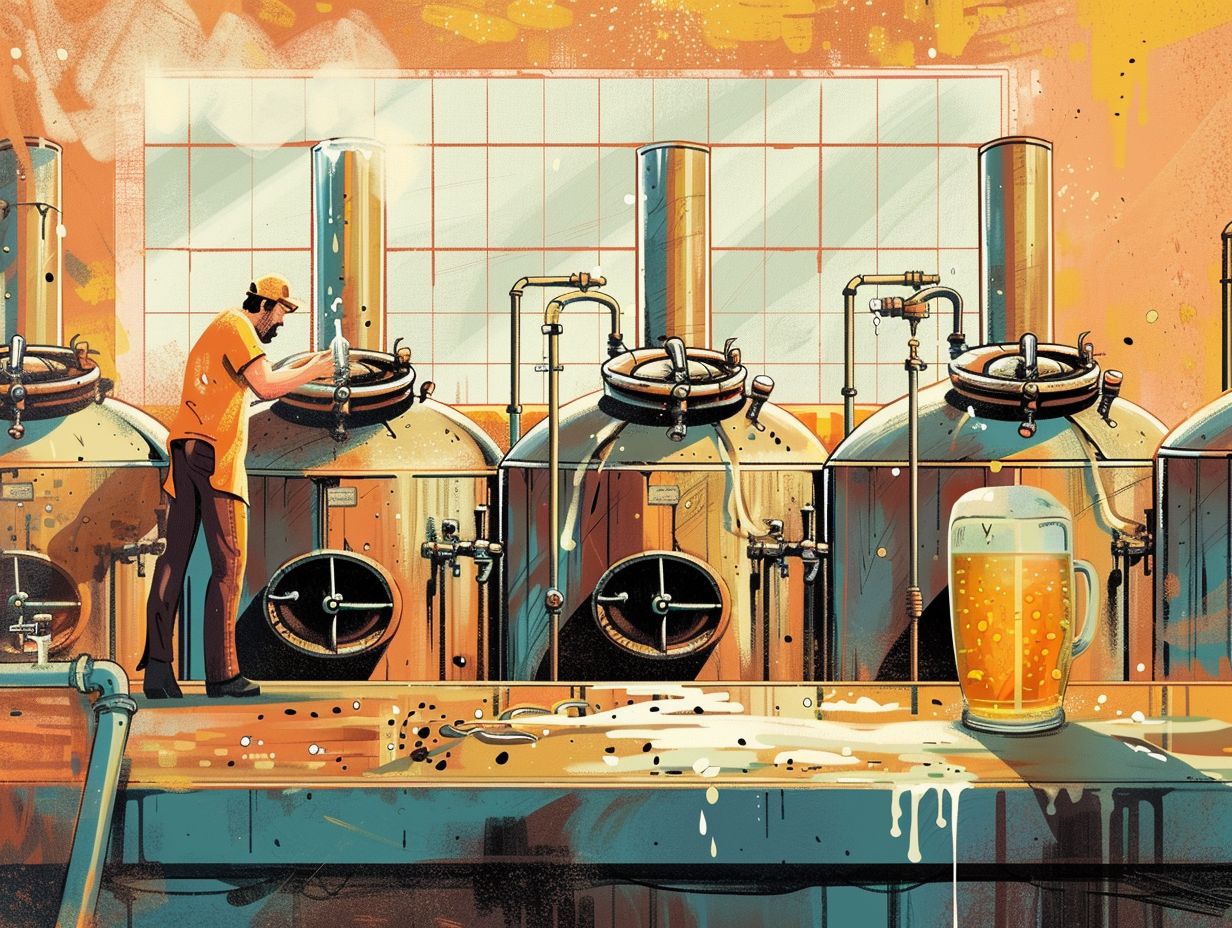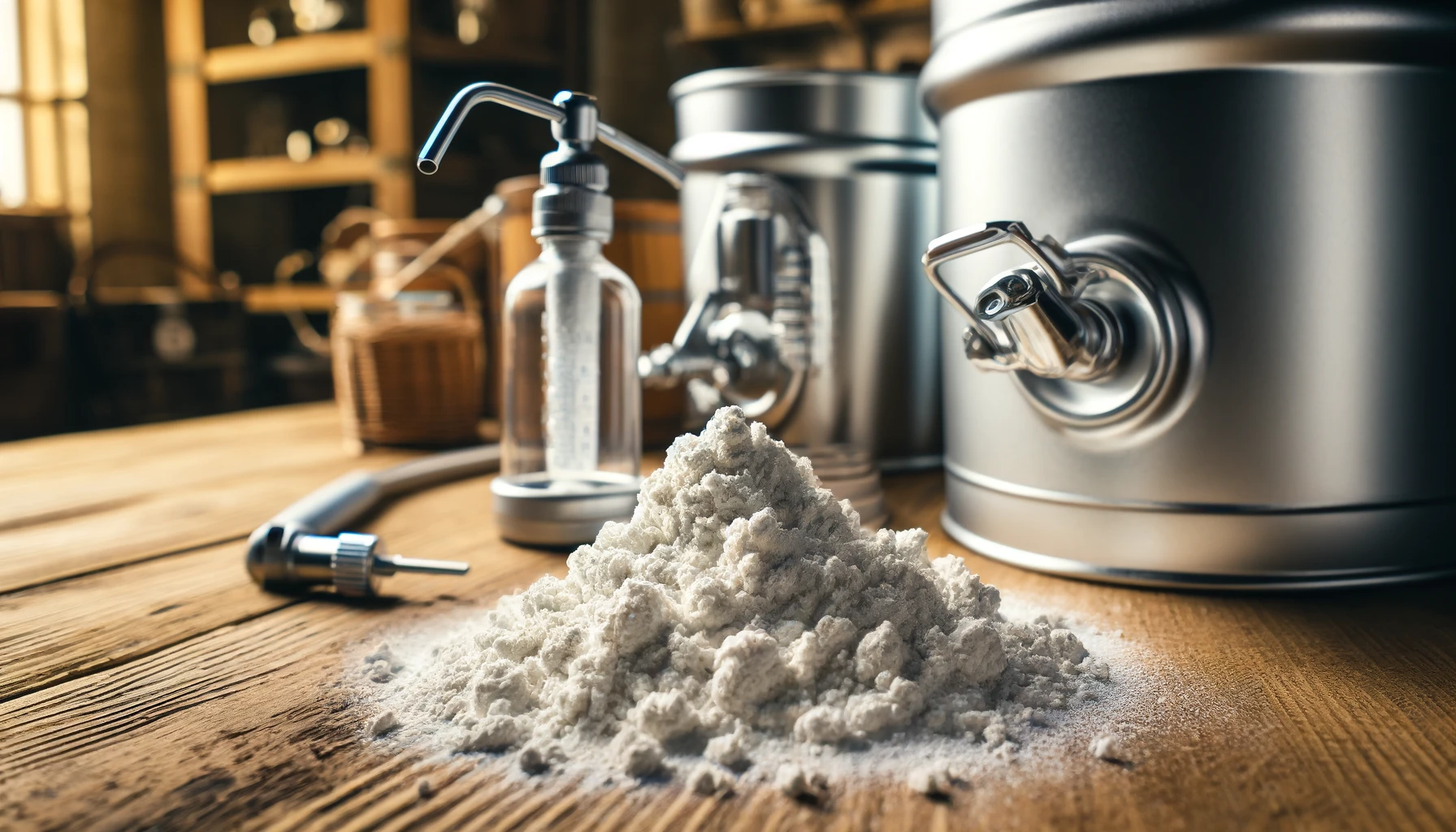Interested in improving the clarity of your homebrewed beer?
Explore the benefits of Sparkolloid. This article will explain what Sparkolloid is, how it is used in brewing, and which beer styles can benefit from its use.
We will also cover the methods of incorporating Sparkolloid into your brewing process, its advantages, potential drawbacks, and alternative clarifying agents.
Discover how to make your brew unique.
What Is Sparkolloid?

Sparkolloid is a commonly used clarifying and fining agent in brewing, especially in the production of wine and beer. It is recognized for its effectiveness in creating clear beverages.
Many homebrewing enthusiasts use Sparkolloid to improve the appearance of their creations by eliminating haze and sediment, resulting in a clear and polished final product. Sparkolloid is not only utilized in commercial brewing but also valued by hobbyists for its ability to clarify homemade wines and beers, giving them a professional look.
Due to its widespread availability and user-friendly nature, Sparkolloid has become a popular choice for individuals looking for a straightforward and dependable method to achieve exceptional clarity in their brewed beverages.
How Is Sparkolloid Used In Brewing?
In brewing, Sparkolloid serves as a clarifying agent to improve beverage quality by efficiently removing sediment and achieving clear results. Sparkolloid is commonly incorporated during the later stages of the brewing process, usually post-fermentation. The dosage of Sparkolloid varies based on the brewer’s specific needs and batch volume. Adhering to the recommended dosage instructions is essential for optimal outcomes. Once introduced to the beverage, Sparkolloid functions by binding with suspended particles in the liquid, prompting them to settle more quickly. This clarification process enhances the visual appeal and refinement of the final product.
What Types of Beer Styles Use Sparkolloid?
Sparkolloid is commonly used in a variety of beer styles, such as craft beers and homebrewed batches, because of its efficient settlement process and compatibility with different brewing techniques.
It works by effectively binding to haze-causing particles and yeast in suspension, helping to clarify beer and enhance its visual appearance and taste. Whether brewing a lager, IPA, or stout, Sparkolloid is essential for achieving the desired clarity and quality in the final product. Homebrewers especially value its user-friendly nature and consistent results, which bring professional-grade clarity to their creations.
What Are the Steps for Using Sparkolloid in Brewing?
The process of using Sparkolloid in brewing involves specific instructions such as determining the appropriate dosage rates, allowing sufficient settling time, and closely monitoring the clarifying process for optimal results.
To incorporate Sparkolloid into the brewing process, start by determining the correct dosage rate, typically around 1/2 to 2 teaspoons per 5 gallons of beer or cider. Gradually sprinkle the measured Sparkolloid into the vessel, stirring gently to distribute it evenly. After adding Sparkolloid, ensure that the mixture is well-mixed and then allow it to settle undisturbed for 2-3 days. It is important to monitor the settling process closely, observing the formation of a compact sediment at the bottom which indicates successful clarification.
What Are the Benefits of Using Sparkolloid in Brewing?
The use of Sparkolloid in brewing provides several advantages, such as producing clear beverages, efficient clarification, elimination of yeast, and enhancing the overall quality of the final product.
This fining agent functions by attracting and binding suspended particles like yeast, proteins, and tannins in the liquid, causing them to settle at the bottom. This process not only aids in creating visually appealing beverages but also enhances their flavor by eliminating undesirable components. The outcome is a smoother texture, improved aroma, and a cleaner aftertaste.
Sparkolloid is user-friendly, eco-friendly, and cost-efficient, making it a favored option among brewers aiming to enhance the quality of their brews.
1. Improves Clarity of Beer
One of the notable advantages of utilizing Sparkolloid is its capacity to significantly enhance the clarity of beer. This leads to a visually appealing and clear appearance that elevates the overall quality of the brew.
The enhanced clarity is achieved through Sparkolloid’s fining properties, which effectively bind with haze-causing particles in the beer. This process facilitates the sedimentation and clarification of the beer. Consequently, the beer not only appears more professional but also highlights the brewer’s meticulous attention to detail. The improved visual appeal goes beyond aesthetics, signaling a brewing process of high quality that prioritizes precision and consistency. Consumers are often attracted to beers with such clarity as it conveys a sense of skill and purity in the final product.
2. Reduces Haze and Sediment

Sparkolloid is a product that effectively reduces haze and sediment in beer by aiding in the settling process, leading to a cleaner and clearer final product that meets quality standards.
When introduced to beer during the brewing process, Sparkolloid functions by attracting and binding to the suspended particles within the liquid. This binding action causes these particles to conglomerate into larger clusters, facilitating their settling to the bottom of the container.
Consequently, the beer’s appearance becomes clearer, with enhanced transparency and decreased sediment. Brewers often value the improved visual quality that Sparkolloid imparts to their end product, as it bestows a professional and refined look to the beer that can be particularly attractive to consumers.
3. Shortens Conditioning Time
Another significant advantage of Sparkolloid is its capability to reduce the conditioning time of beer, resulting in more efficient brewing processes and quicker production of high-quality beverages. This innovative fining agent functions by binding effectively with undesired particles in the beer, such as proteins and yeast, facilitating prompt sedimentation and clarification.
By improving the clarity and stability of the end product in a shorter period, Sparkolloid assists brewers in achieving faster turnaround times without compromising the sensory characteristics or flavor profile of the beer. This streamlined approach not only enhances productivity but also guarantees that the beer upholds its desired quality standards, positioning it as a valuable asset for breweries seeking to optimize their production timelines while consistently delivering exceptional brews.
4. Cost-effective
Sparkolloid is a cost-effective solution in brewing, as it enhances process efficiency, improves quality, and delivers favorable outcomes without incurring significant additional expenses.
Its ability to clarify beer quickly and effectively makes it a valuable tool for breweries seeking to streamline their production processes. By reducing the time required for clarification, Sparkolloid not only saves on labor costs but also minimizes product loss, leading to higher overall profitability. The economic benefits of utilizing Sparkolloid extend beyond operational efficiency, as the improved quality of the final product can result in enhanced customer satisfaction and increased brand loyalty, ultimately translating into higher sales and revenue for the brewery.
What Are the Potential Side Effects of Using Sparkolloid in Brewing?
While Sparkolloid provides various benefits, it is important to consider potential side effects, such as flavor changes in beer and the risk of allergic reactions in susceptible individuals.
The use of Sparkolloid in brewing can result in alterations to the taste of the beer, leading to subtle variations that may not match the brewer’s original intention. Some individuals may develop allergic reactions to components of Sparkolloid, which could present as skin rashes, itching, or swelling. To address these possible side effects, brewers are encouraged to conduct small-scale trials before full production to understand how Sparkolloid interacts with their specific ingredients and processes. It is also vital to communicate any known allergies or sensitivities to all team members involved in the brewing process to prevent adverse reactions.
1. Can Affect Flavor of Beer
The use of Sparkolloid in the beer-making process can have an impact on the flavor profile of the beer. This can result in alterations in the taste, aroma, and overall quality of the brewed beverage.
Some brewers believe that beers treated with Sparkolloid can have a smoother and cleaner finish, while others caution about potential flavor changes. In terms of aroma, the use of Sparkolloid can influence the beer’s scent by either enhancing or diminishing the hops or malt notes.
To ensure that the flavor profile remains intact, it is crucial to maintain precise dosage levels and clarity objectives when incorporating Sparkolloid into beer production.
2. May Cause Allergic Reactions
Another consideration to keep in mind when using Sparkolloid is the potential for allergic reactions in individuals sensitive to its ingredients. This underscores the importance of understanding and managing potential allergens.
Just like with any substance, it is essential for brewers to remain alert in identifying the signs of an allergic reaction. Symptoms such as skin rashes, itching, swelling, or respiratory issues should not be disregarded and need to be promptly addressed. To ensure the safe application of Sparkolloid, it is advised to thoroughly examine the product’s label for any potential allergens and perform a patch test before full-scale use. Maintaining a clean brewing environment and using protective gear can help reduce the risk of exposure to allergens during the brewing process.
Are There Any Alternatives to Sparkolloid in Brewing?

In brewing, various alternatives to Sparkolloid are available, such as Irish Moss, Gelatin, Bentonite, Isinglass, and Biofine Clear, providing brewers with a range of choices to achieve clarity and quality in their beverages.
Irish Moss, a fining agent made from seaweed, is commonly used to assist in precipitating proteins during the brewing process.
Gelatin, sourced from animal collagen, is effective in eliminating haze-causing particles.
Bentonite, a clay-based fining agent, is recognized for its capacity to eliminate proteins, tannins, and other impurities.
Isinglass, derived from fish bladder, is frequently utilized in cask-conditioned ales to clarify the beer.
Biofine Clear, a vegan-friendly option, is suitable for individuals seeking a plant-based substitute for traditional fining agents.
1. Irish Moss
Irish Moss is commonly used as a substitute for Sparkolloid in brewing due to its settlement mechanism and effectiveness in achieving clarity, making it a popular choice among brewers.
One of the key benefits of Irish Moss is its natural origin, which appeals to brewers seeking organic options. In contrast to Sparkolloid, a fining agent derived from synthetic sources, Irish Moss offers a more environmentally friendly alternative.
Irish Moss is versatile in its application, proving effective in various beverages to improve visual appeal and taste. While both Irish Moss and Sparkolloid serve to clarify the brew, Irish Moss tends to settle more rapidly, reducing the waiting period for brewers eager to observe results.
2. Gelatin
Gelatin is considered an alternative to Sparkolloid in brewing, valued for its efficacy in yeast removal, quality enhancement, and positive outcomes in clarifying beverages. While Sparkolloid is a popular choice in brewing due to its fining properties, gelatin provides a cost-effective and efficient method for achieving beverage clarity.
When introduced into the brew, gelatin functions by binding with yeast particles, proteins, and other suspended particles, causing them to form larger clumps that settle at the bottom of the container. This mechanism facilitates the elimination of undesired sediment, resulting in a clearer and visually appealing end product.
The utilization of gelatin is recognized for enhancing the overall quality and stability of beer or wine by reducing haze-causing compounds and improving mouthfeel. Brewers often favor gelatin due to its straightforward application process and consistent results, underscoring its significance as a valuable asset in the brewing procedure.
3. Bentonite
Bentonite is used as a natural alternative to Sparkolloid in brewing, appreciated for its effectiveness in the clarification process and its ability to improve the quality of beverages through natural methods.
It is interesting how Bentonite, a naturally occurring clay mineral, possesses noteworthy clarifying properties that are advantageous for brewers who prefer a more natural approach to fining their beverages. Unlike chemical additives, Bentonite provides an organic solution that is mild yet highly efficient in eliminating undesired particles from the final product. Its adaptability to various brewing techniques makes it a versatile option for individuals aiming to achieve a clear, visually appealing brew without compromising on quality or flavor.
4. Isinglass
Isinglass is positioned as an alternative to Sparkolloid in brewing, recognized for its fining properties that help improve the quality and outcome of the final beverages.
Isinglass, which is obtained from fish bladders, has been a preferred choice among brewers for centuries because of its capability to efficiently clarify and stabilize beer and wine. This natural substance functions by attracting and binding to undesired particles present in the liquid, allowing them to settle and resulting in a clearer, brighter appearance.
Apart from its clarifying characteristics, Isinglass also has a minimal impact on the flavor and aroma of the finished beverage, rendering it a popular option for brewers aiming to produce a clean and refined product.
5. Biofine Clear
Biofine Clear is considered an organic substitute for Sparkolloid in brewing, known for its sustainable characteristics, organic composition, and the quality it adds to beverages during the clarification process.
Brewers who value sustainability and eco-friendly practices are increasingly choosing Biofine Clear as a premium option for achieving clear and refined beverages. Its environmentally friendly attributes are attributed to its use of natural, plant-based ingredients, making it a preferred choice for those in search of organic solutions.
The appeal of Biofine Clear is not only its sustainable qualities but also the improved quality it provides to the final product. By selecting this organic alternative, brewers can ensure that their clarified beverages not only have a pristine appearance but also offer exceptional taste.
Frequently Asked Questions

What is Sparkolloid?
Sparkolloid is a fining agent used in brewing to clarify beer and wine. It is a combination of diatomaceous earth and acid-treated bentonite clay.
How is Sparkolloid used in brewing?
Sparkolloid is added to the finished beer or wine to remove any haze-causing particles, resulting in a clearer and brighter appearance. It is commonly used in conjunction with other fining agents.
What are the benefits of using Sparkolloid in brewing?
Using Sparkolloid in brewing can improve the overall appearance and shelf stability of the beer or wine. It can also help reduce the amount of time needed for cold crashing or aging.
Is Sparkolloid safe to use in brewing?
Yes, Sparkolloid is considered safe for consumption and is approved for use in food and beverage production by the FDA. It is also vegan-friendly and does not affect the flavor or aroma of the final product.
How much Sparkolloid should be used in brewing?
The recommended dosage of Sparkolloid varies depending on the specific brand and type used. It is important to follow the manufacturer’s instructions and adjust accordingly for different batch sizes.
Can Sparkolloid be used in all types of beer and wine?
Sparkolloid is most commonly used in light-colored and clear beers and wines, but can also be effective in darker varieties. However, it may not be as effective in heavily hopped or high alcohol beverages.





Leave a Reply
You must be logged in to post a comment.